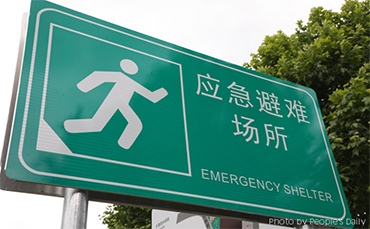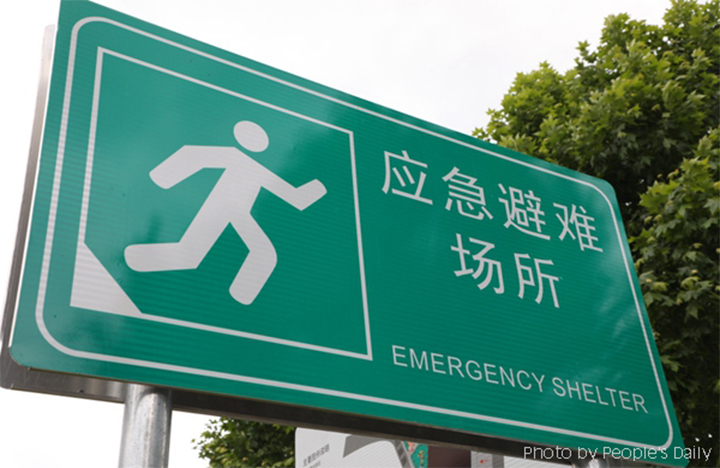



▲ The signage of the emergency shelter of Wanda Plaza in Guanshanhu District, Guiyang, Guizhou province. [Photo by People's Daily]
3. Planning Alignment.
As a special plan of the territorial planning system, the plan for emergency shelters should align with the national economic and social development plans, and territorial master plan at the same level, and coordinate with plans including an emergency response system, civil air defense, comprehensive disaster prevention and control, recovery and reconstruction, etc., and the main contents should be integrated into the detailed territorial plan. The planning period should, in principle, be consistent with the territorial master plan at the same level.
4. Main Contents.
4.1 Current development of economic, social, and emergency management.
Analyze the current development of economic and social, emergency management, and their impact on emergency shelters to provide a basis for the research and preparation of special plans.
4.2 Current development and analysis of the venues of emergency shelters.
Summarize the development history of emergency shelters, assess the current venue condition of emergency shelters, and analyze the main issues based on the current status of emergency management and survey of emergency shelter resources.
4.3 Analysis of emergency shelter needs and resources.
This includes disaster and risk analysis, emergency evacuation population analysis, and emergency shelter resources survey and analysis. The results will be shared and used to support the specialized assessment of territorial planning.
4.4 Planning objectives and indicators.
According to the relevant conditions and the overall requirements for the establishment of an emergency system, the planning objectives should be clearly addressed, emergency evacuation policies should be formulated, and the planning indicators should be specified based on the relevant contents.
4.5 Development and layout planning for emergency shelters.
In conjunction with the planning objectives and strategies for the emergency shelters, plan the grade and classification of emergency shelters, layout of urban-rural emergency shelters, evacuation roads, and related urban-rural infrastructure.
4.6 Design guidelines for emergency shelters.
Based on the grade and type of emergency shelters, design guidelines should be proposed for the site selection, service scope, function partitions, facilities and equipment, material reserves, information system, etc.
4.7 Implementation.
(1) Key tasks. Based on the analysis of the current development of emergency shelters, emergency shelter needs, planning objectives, and emergency shelter strategies, determine the implementation key tasks, and specify construction goals as well as requirements.
(2) Implementation progress. Optimize the implementation progress and determine the phased implementation plan according to the key tasks, project funding, urban development plans, and other constraints.
4.8 Guarantee measures.
To promote the successful implementation of the plan, guarantee measures in terms of organizational leadership, supervision and assessment, fund coordination, and social participation should be developed.
5. Technical Points.
5.1 Preliminary research and analysis.
(1) Collection: Collect basic data and information on emergency management, disaster prevention, epidemic prevention, and air defense. Obtain the latest approvals and ongoing implementation of relevant planning outcomes. Refer to statistical yearbooks. And review statistical bulletins.
(2) Identify the types, grades, and spatial distribution of relevant disaster and accident risks.
(3) Analyze geographical and geological environments, meteorological and hydrological conditions, and other natural environmental features.
(4) Propose planning and construction notes.
(5) Evaluate various resources related to disaster prevention, epidemic prevention, and air defense.
(6) Establish a database for emergency shelter resources.
5.2 Planning objectives and indicators.
(1) Planning objectives should align with the requirements of upper-level plans, and be long-term and practical.
(2) In conjunction with relevant plans, determine the grade and classification of emergency shelters, the urban-rural layout of emergency shelters, quantity and scale of emergency shelters, service guarantee capabilities of emergency shelters, and other construction requirements.
(3) Indicator system: the system should include indicators such as the number of refugees who can be accommodated, the percentage of refugees who can be accommodated in indoor and outdoor emergency shelters, effective and safe areas for emergency congregate sheltering, etc.
5.3 Grade and classification system.
(1) Based on factors such as administrative divisions, population distribution, the scope of disaster impacts, and capabilities of disaster prevention and control, determine the quantity, scale, and construction requirements of different grades and types of emergency shelters.
(2) Strictly control the construction of emergency shelters with a single function.
(3) Encourage the construction of indoor, comprehensive, and rural emergency shelters.
5.4 Development layout of emergency shelters.
(1) Reasonably determine the grade and classification of emergency shelters.
(2) Adhere to the principle of safety first, the rural areas should consider the need to avoid danger and disaster for the masses as well as the emergency rescue and plan and build emergency shelters while equipping them with facilities and materials to improve the capability of emergency shelters in rural areas.
(3) Site selection: avoid earthquake fault zones, geological hazards and danger areas, flood-prone areas, etc.; where avoidance is not possible, engineering preventive measures must be taken; keep away from flood areas, flood discharge areas, main flood channels, torrent threaten areas, high-tension line corridors, etc.; avoid gas transmission pipelines, oil transmission pipelines, storage areas for flammable, explosive, toxic hazardous materials, nuclear radiation materials, and other areas prone to secondary disasters; avoid areas affected by the collapse and falling debris of surrounding buildings and structures; consider convenient access for vehicles and pedestrians to facilitate emergency shelters for the masses.
5.5 Evacuation roads and related infrastructure.
(1) There should be at least two evacuation roads connecting with the outside in different directions with barrier-free facilities.
(2) The requirements for evacuation roads in rural areas could be slightly adjusted according to local conditions.
(3) There should be no less than two interfaces of the water supply system with emergency shelters located on different road sections.
(4) The wastewater sewage system of emergency shelters should be connected to the relevant sewage system.
(5) Emergency power supply should be planned for emergency shelters.
Source:
<https://www.mem.gov.cn/gk/zfxxgkpt/fdzdgknr/202312/W020231226676387872729.pdf>
<https://mp.weixin.qq.com/s/1J48Fi6tqXHfQUO9HJ5LUA>
Edited and Translated by Guo Xinxin